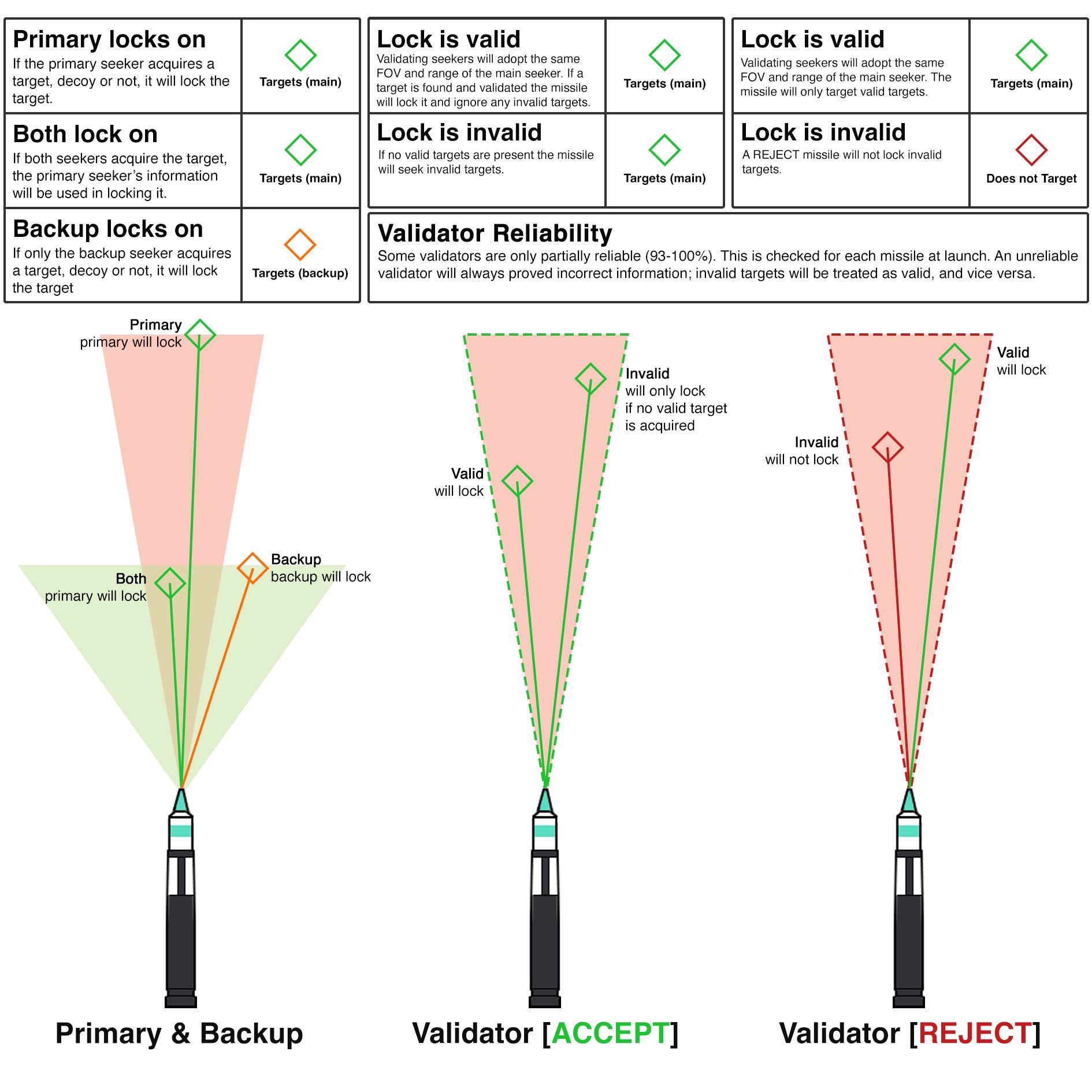Missiles: Difference between revisions
(→Targeting: Added validator and backup seeker sections) |
(→Seeker: added HOJ to table) |
||
| Line 155: | Line 155: | ||
| [[File:Seeker semiactive fixed.png|25px]] Fixed Semi-Active Radar Seeker || RADAR || 4000 || 50 || 95 || <span style="color:red;">'''No'''</span> || <span style="color:green;">'''Yes'''</span> || <span style="color:green;">'''Yes'''</span> || <span style="color:red;">'''Direction Only'''</span> || <span style="color:green;">'''Yes'''</span> || 0 | | [[File:Seeker semiactive fixed.png|25px]] Fixed Semi-Active Radar Seeker || RADAR || 4000 || 50 || 95 || <span style="color:red;">'''No'''</span> || <span style="color:green;">'''Yes'''</span> || <span style="color:green;">'''Yes'''</span> || <span style="color:red;">'''Direction Only'''</span> || <span style="color:green;">'''Yes'''</span> || 0 | ||
|- | |- | ||
| [[File:Seeker arh fixed.png|25px]] Fixed Anti- | | [[File:Seeker arh fixed.png|25px]] Fixed Anti-Radiation Seeker || PSV RADAR || 3000 || 50 || 93 || <span style="color:red;">'''No'''</span> || <span style="color:green;">'''Yes'''</span> || <span style="color:green;">'''Yes'''</span> || <span style="color:red;">'''Direction Only'''</span> || <span style="color:red;">'''No'''</span> || 2 | ||
|- | |||
| [[File:Seeker arh fixed.png|25px]] Fixed Anti-Radiation Seeker (Home On Jam) || PSV RADAR || ∞ || 50 || 93 || <span style="color:red;">'''No'''</span> || <span style="color:green;">'''Yes'''</span> || <span style="color:green;">'''Yes'''</span> || <span style="color:red;">'''Direction Only'''</span> || <span style="color:red;">'''No'''</span> || 0.5 | |||
|- | |- | ||
| [[File:Seeker eo.png|25px]] Electro-Optical Seeker || EO || 3000 || 60 || 100 || <span style="color:green;">'''Yes'''</span> || <span style="color:green;">'''Yes'''</span> || <span style="color:green;">'''Yes'''</span> || <span style="color:green;">'''Yes'''</span> || <span style="color:red;">'''No'''</span> || 8 | | [[File:Seeker eo.png|25px]] Electro-Optical Seeker || EO || 3000 || 60 || 100 || <span style="color:green;">'''Yes'''</span> || <span style="color:green;">'''Yes'''</span> || <span style="color:green;">'''Yes'''</span> || <span style="color:green;">'''Yes'''</span> || <span style="color:red;">'''No'''</span> || 8 | ||
Revision as of 17:05, 22 June 2024
Missiles are the most powerful weapons a ship can carry but they have limited ammunition, can be shot down and fire slower than other weapons. The number of missiles that can be prepared to fire at the same time depends on the ship's maximum salvo size.
Missile Mechanics
Targeting
Target Selection Cycle
Most seekers choose targets with a lottery. Every 0.5 seconds, the seeker sweeps its cone for targets and adds them to a list. Note that this list is not stored between search cycles, the only thing the missile remembers is the "current target".
- Each target is given an initial score based on its power, how strong the signal is. All powers fall off with distance, so closer targets are usually scored higher initially.
- ACT and SARH power is based on the radar return power density. Also, targets further from the center of the missile's view are scored lower, down to 50% at the edge. ACT power is based on the distance from the missile to the target while SARH is based on the distance from the illuminator to the target and the offset angle between the missile and the illuminator
- For the EO seeker, ship size does not matter; ships give off the same "optical" power, modified only by their distance to the seeker.
- If the missile has an active validator, the validator checks each target and marks it as valid or invalid (this is not saved between seeker cycles for validators other than [ARAD], which has a 30 second memory)
- If the missile has multiple validators, every validator will check each target.[1]
- If the seeker is set to accept unvalidated, and at least one target is valid, then every invalid is removed from the list. If no targets are valid, then the validator is ignored.
- If the seeker is set to reject unvalidated, invalid targets are always ignored.
- The scores of the targets are then modified based on a few factors
- If the missile has a current target, and that target appears in the list again, then:
- If the current target is closer than the seeker's Lock Current Target Distance stat (500 m - 2500 m for different seekers), the seeker is guaranteed to choose this target again.
- Otherwise, if the current target is not a decoy, its score is multiplied by the Target Affinity stat of the seeker (10x for most seekers, 3x for WAKE).
- If the seeker is EO, and it was fired at a track with intel, all targets matching the same ship class have their scores multiplied by 250.
- If the missile has a current target, and that target appears in the list again, then:
- Select a random target weighted by the scores of the targets remaining in the list.
CMD seekers do not undergo this process as their only target is the track they were fired on.
If the seeker is under jamming, the target's return power has to exceed the combined jamming power felt by the seeker to detect the target and add it to the lottery. Note that this is slightly different from the search radar calculations, as the combined jamming power is compared directly without converting it to noise first. As a result, missile seekers are not affected by ambient noise at all.
If the seeker is jammed and cannot see any targets, it will follow a fake target, therefore causing the missile to veer off target. This fake target is placed 1km away from the missile, at a random point up to 4 degrees off the nose with a velocity of 10m/s in a random direction, and changes once every second. Equipping the missile with any validator and setting the seeker to reject unvalidated will push the fake target out to 50km, preventing premature staging if the seeker can detect range.
Validation
All seekers can be set to validation mode. When a seeker is operating in Validation mode, it does NOT provide its original function. Instead, it validates target tracks spotted by the targeting seekers, and tags them valid or invalid.
The validator checks every track spotted by the targeting seekers, ignoring the validator's default range and seeker cone. These targets are tagged valid if the validator can also see it, and tagged invalid otherwise. Validators otherwise spot targets in the same way as if it was a targeting seeker.
Validator reliability is the chance that the validator will provide accurate info. The seeker rolls its validator chance once on launch. If the check fails, the validator will always be wrong (eg, an invalid target will be tagged valid, and a valid target will be tagged invalid).
Validators can negate some secondary effects of jamming when paired with a targeting seeker set to reject unvalidated (assuming the validator itself is not jammed). The seeker will not follow the fake targets produced by jamming (unless the validator is also affected or attracted to the jamming source), and seekers will not stage early due to jamming (unless the seeker cannot detect distance, as the way this is achieved under the hood is just by pushing the fake target from 1km to 50km). Both of these effects are not affected by validator reliability. Note that validators otherwise do not improve the seeker's ability to acquire targets through jamming; the targeting seeker will spot targets at the same range regardless if it has a validator or not.
Validators will apply to all targeting seekers in the missile, even if the targeting seeker is placed behind the validator.
Backup Seeker
Seekers in targeting mode placed in slots behind other seekers will function as backup seekers. They will only activate if the seekers ahead of them do not see a target. If a seeker has an active backup behind it, it can automatically turn itself off in the event of jamming, preventing early staging and following fake targets, and allowing the backup seeker to take over. However, note that the backup itself will not turn itself off when jammed, even if the primary has a clear view; the backup will only turn off if it also has another backup.
Backups will also utilize any existing validators, regardless of position.
Missile Construction
Missiles can be designed and colored in the fleet editor. If a design is deleted it will be removed from all missile launchers in the fleet.
Selecting a missile's engine will show the engine configuration triangle, allowing the engine to be focused on Top Speed, Maneuverability or Turn Rate.
Payload
The payload determines how a missile inflicts damage. The exact damage type depends on the size of the missile.
Avionics Package
The avionics package determines how the missile is controlled. It has the following configuration options:
- Weapon Role sets how the missile may be launched:
- DEFENSIVE: Missiles can be launched manually and by the point defense system.
- OFFENSIVE: Missiles can be launched manually.
- Launch Type sets the behavior immediately after launching:
- HOT: The missile's engine will ignite immediately, good for getting the missile moving quickly when fired in range of enemy point defenses.
- COLD: The missile will maneuver around the launching ship with thrusters until it has an unobstructed line to the target or first waypoint before igniting the main engines.
- Target Lost Behavior sets what the missile will do if it loses the target:
- RESUME SEARCH: The missile will search for a new target.
- SELF DESTRUCT: The missile will self destruct.
- Terminal Maneuvers sets what evasive maneuvers the missile will perform on its terminal approach to the target:
- NONE: No evasive maneuvers.
- WEAVE: Missile will weave from side to side.
- CORKSCREW: Missile will spiral towards the target.
- Trajectory Preference sets the approach angle the guidance system will try to maintain.
- FREE APPRAOCH: Missile will fly directly towards the target.
- MINIMUM ANGLE: Missile will try to avoid getting between the launch ship and the target.
Seeker
The seeker determines the method the missile uses to track its target. Most seekers can choose whether to ignore small targets such as other missiles or not. If a missile has two seekers the secondary one (the one not placed at the nose of the missile) can be set to a Seeker Mode:
- TARGETING: Secondary seeker will be used to acquire a target if the primary seeker does not find any.
- VALIDATION: Secondary seeker will be used to validate targets. Missile will favor targets validated by both seekers, greatly reducing the effectiveness of enemy decoys.
Auxiliary
Auxiliary components can be used to grant a bonus to the missile. They can only be used on missiles that include at least 4 components.
- ↑ It can be assumed that the final result will either require all validators or only one validator in order to count as passed, but there appears to be a bug where the pass/fail status is set by an assignment operator rather than a bitwise operator, making each validator overwrite the previous one, resulting in only the last validator in the list having an impact.
 Hooded Horse Wikis
Hooded Horse Wikis

